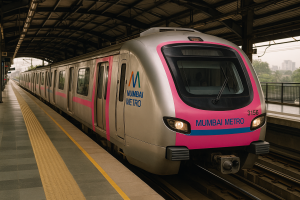One of the most important factors to consider when purchasing a property is its location. It is a key factor in determining the value of a property. A good location is distinguished by the presence of social infrastructure facilities such as top-rated schools and reputable hospitals, as well as connectivity to arterial roads and transportation links, upcoming infrastructure developments, and proximity to commercial hubs. Thus, real estate in such areas has the potential for growth, resulting in high property prices.
The real estate landscape in India’s top cities and several tier 2 cities has shifted dramatically in recent years, thanks to the government’s emphasis on infrastructure and key initiatives such as affordable housing. As major cities become saturated and smaller cities gain importance as employment hubs emerge, the demand for housing has skyrocketed in tier 2 cities such as Bhopal, Jaipur, Lucknow, Nagpur, and others. Several real estate investors are frequently perplexed about whether they should buy a property in the top metro cities or look for opportunities in tier 2 or tier 3 markets. In this article, we will look deeper into the benefits and drawbacks of investing in these real estate markets.
Tier 1 vs Tier 2 vs Tier 3 cities in India
| Parameter | Tier 1 city | Tier 2 city | Tier 3 city |
| Definition | Cities in India are classified based on their population size of one lakh or more. | Cities in India are classified according to their population size, which ranges from over 50,000 to 99,000. | Cities in India are classified according to their population size, which ranges from 20,000 to 49,000. |
| Examples | These include India’s eight metropolitan cities. | Major cities include Jaipur, Chandigarh, Ahmedabad, Lucknow, and others. | Smaller towns include Aligarh, Meerut, and Trichy. |
| Economic development | These cities are urban centres with high economic activity and well-established business and commercial hubs. | These cities are experiencing economic growth and serve as emerging business and commercial hubs. | These cities see an increase in economic activity, including smaller businesses. |
| Infrastructure | Tier 1 cities have well-developed infrastructure, such as metro stations and airports. | Tier 2 cities are experiencing rapid infrastructure development. | Tier 3 cities’ infrastructure is currently in development. |
| Cost of living | The cost of living in major cities like Mumbai and Bangalore is extremely high. | Tier 2 cities have lower living costs than metro cities, but these costs are gradually rising as a result of rapid development. | Tier 3 cities have lower living costs than other cities due to their limited facilities. |
| Job opportunities | The top metro cities have thriving IT and finance sectors, major industries, and the presence of global companies, all of which attract a large number of working professionals each year. | Many tier 2 cities have seen the expansion of IT hubs, regional industries, and startups, which employ a sizable portion of the workforce. | Tier 3 cities have fewer job opportunities, with smaller industries and local businesses accounting for the majority of them. |
| Property rates | The high demand for property in the top eight cities has resulted in high prices. | Property prices in Tier 2 cities are relatively low, but they are steadily rising due to rapid infrastructure development and increased demand. | Property prices in Tier 3 cities are generally lower than in other cities. |
Buying property in India’s Tier 1 cities
The top eight cities, Mumbai, Pune, Ahmedabad, Bangalore, Chennai, Hyderabad, and Kolkata–drive economic activity and contribute significantly to the national GDP. These cities are known for their strong infrastructure, high-quality healthcare facilities, educational institutions, thriving commercial centres and business hubs, and excellent connectivity via airports, metros, and other means. These cities have a high demand for residential properties due to the abundance of job opportunities and high quality of living they provide. Furthermore, advancements in infrastructure, such as expanding metro networks, new motorways, and road projects, drive property demand in these cities. Furthermore, due to these factors and the high demand for housing, rentals are significantly higher. As a result, property investors should expect higher returns in these cities.
Pros of tier 1 city
These cities have advanced infrastructure and numerous job opportunities, resulting in a high standard of living. Property prices continue to rise in the top eight cities, creating opportunities for higher returns.
Cons of tier 1 city
The growing population, which causes congestion and traffic, as well as the high cost of living, are important factors to consider if one intends to stay in a Tier 1 city.
Latest property trends in tier 1 cities
According to the most recent Housing.com report for June 2024, growth in the top eight cities’ property markets has remained strong, with significant price increases and a decrease in unsold units. The demand for luxury homes in tier 1 cities has increased as a result of changing lifestyles and rising disposable income. Furthermore, cities like Delhi-NCR have a greater supply of ready-to-move-in housing units, whereas Ahmedabad has seen a high number of new launches.
Furthermore, the IRIS index report for September 2024 shows that online property searches have increased by 10% month on month. The most popular localities are Noida Extension in Greater Noida, Andheri West and Mira Road East in Mumbai, Whitefield in Bangalore, and New Town in Kolkata. According to the report, Delhi-NCR remained the top destination for online searches in August due to strong investor confidence and end-user demand. According to the report, there is a high demand for affordable to mid-range properties priced between Rs 50 lakh and Rs 1 crore. In addition, the report stated that approximately 50% of prospective buyers sought ready-to-move-in homes.
Indore ranked first among tier 2 cities due to its infrastructure development and environmentally friendly living options. It was quickly followed by Jaipur, Lucknow, and Vadodara. In these cities, people primarily looked for 3BHK homes, followed by residential plots and 2BHK homes priced at Rs 50 lakh or less.
Price Trends in India’s Top Tier One Cities
| City | Average price | Price appreciation (YOY) | Average monthly rentals |
| Delhi | Rs 13,300 | -8.48% | Rs 46,000 |
| Mumbai | Rs 21,800 | 7.6% | Rs 71,000 |
| Pune | Rs 7,700 | 9.69% | Rs 29,000 |
| Ahmedabad | Rs 6,300 | 0.35% | Rs 27,000 |
| Bangalore | Rs 9,200 | 7.63% | Rs 33,000 |
| Chennai | Rs 7,600 | 1.71% | Rs 33,000 |
| Hyderabad | Rs 7,300 | 3.46% | Rs 32,000 |
| Kolkata | Rs 5,500 | -2.98% | Rs 21,000 |
Buying property in India’s Tier 2 cities
Several tier 2 cities in India are emerging as real estate hotspots, with strong demand for properties. The saturation and crowding of major cities has pushed people to satellite cities and smaller cities in search of jobs and a higher quality of life.
Tier 2 cities are becoming popular real estate destinations for a variety of reasons, including:
Growth of employment hubs: Some tier 2 cities, such as Bhopal, Kochi, Jaipur, and Lucknow, have attracted IT firms, multinational corporations, and start-ups, resulting in a plethora of job opportunities.
Fast-developing infrastructure: Infrastructure in these cities is rapidly developing, whether it is a metro network or future airports and motorways.
Good connectivity: Most tier 2 cities have good access to major economic hubs. For example, the Mumbai-Nagpur Motorway is expected to significantly reduce travel time between the two cities, boosting economic activity in the region.
Affordability: Tier 2 cities have lower property prices than tier 1 cities, attracting a large number of homebuyers. As a result, it is a major driver of the demand for affordable housing in these cities.
Pros of tier 2 city
The affordability of tier 2 cities, as well as the expansion of employment opportunities, are significant advantages for property buyers. Furthermore, the infrastructure is rapidly improving.
Cons of tier 2 city
Despite these positive aspects, Tier 2 cities are currently facing some challenges. When compared to the top cities in India, some tier 2 cities have fewer amenities and opportunities. There is potential for the development of amenities that will improve quality of life.
Latest property trends in Tier 2 cities.
Prominent tier 2 cities have seen a double-digit increase in property prices of 10% to 15% year on year, bringing prices close to the top residential markets of Delhi/NCR and Mumbai. The expansion of modern housing projects with high-rise apartments in these cities reflects rising homebuyer preferences. Property prices are expected to rise in the coming years as infrastructure projects such as the upcoming metro are developed, opening up opportunities for higher returns on investment.
Price trends in top tier 2 cities in India
| City | Average price | Price appreciation (YOY) | Average monthly rentals |
| Bhopal | Rs 4,500 | 7.35% | Rs 15,958 |
| Chandigarh | Rs 8,000 | 10% | Rs 35,000 |
| Coimbatore | Rs 5,000 | 0.76% | Rs 10,750 |
| Jaipur | Rs 4,000 | 3.21% | Rs 20,000 |
| Kochi | Rs 5,500 | -6.63% | Rs 30,000 |
| Lucknow | Rs 5,000 | 8.17% | Rs 16,000 |
| Nagpur | Rs 4,800 | -2.01% | Rs 18,000 |
| Nashik | Rs 4,300 | 0.99% | Rs 16,000 |
Buying property in India’s Tier 3 cities
Tier 3 cities in India are still in the development stage, unlike tier 1 and tier 2 cities. Many investors are unsure whether they should invest in tier 3 cities, given the skyrocketing property prices in the major cities. If one is looking for good returns, investing in top cities or prominent tier 2 cities will yield higher returns. Furthermore, these markets are underpinned by consistent end-user demand. As a result, investment in metro cities or top tier 2 cities will produce strong returns due to the possibility of consistent price appreciation.
On the other hand, real estate activity in some tier 3 cities is increasing, causing prices to rise. The availability of undeveloped land expands future real estate growth opportunities. Investment in these cities is expected to increase in the future as a result of the government’s efforts.
Pros of tier 2 city
The lower cost of land, combined with government programs like PMAY (Pradhan Mantri Awas Yojana), has resulted in an increase in real estate development in the city. These cities have a large supply of affordable housing options.
Cons of tier 2 city
One of the primary concerns for homebuyers looking to purchase a residential property in a tier 3 city is a lack of high-quality infrastructure.
Latest property trends in Tier 2 cities
Tier 3 cities have seen an increase in economic activity as industries such as manufacturing, information technology, healthcare, education, and tourism expand. As a result, there is a growing demand for homes among working professionals. This has influenced the development of housing projects in Tier III cities. Furthermore, as infrastructure improves, demand for real estate is expected to rise in the coming years.
Price trends in the top three cities in India.
| City | Average price | Price appreciation (YOY) | Average monthly rentals |
| Amritsar | Rs 6,800 | – | Rs 16,000 |
| Bhubaneswar | Rs 6,700 | 13.42% | Rs 18,000 |
| Surat | Rs 4,100 | -7.22% | Rs 26,300 |
| Mangalore | Rs 5,700 | 9.95% | Rs 16,000 |
| Vijayawada | Rs 6,400 | 14.38% | Rs 13,000 |
| Madurai | Rs 6,000 | 14.97% | Rs 17,000 |
| Meerut | Rs 5,200 | 0.27% | Rs 13,600 |
| Rajahmundry | Rs 4,100 | -17.59% | Rs 15,000 |
Factors to consider when purchasing property in a city.
Property prices: Before purchasing a city property, it is critical to understand price trends. Furthermore, while conducting your research, you may need to look into micro-markets because prices vary by location within the same city. Check to see if the city will meet your budget requirements by considering the cost of living, home loan EMIs, and other factors.
Employment opportunities: When deciding to buy a house in a city for end use, a home buyer should consider whether the area has job opportunities. You may need to research the job markets in these cities and determine whether there are any commercial centres or business hubs there.
Lifestyle needs: Consider your lifestyle requirements before purchasing a city property. Examine the neighbourhood of a location to see if there are any reputable schools, colleges, hospitals, malls, markets, parks, recreational facilities, and so on.
Connectivity: This is an important consideration when choosing a location for real estate investment. The proximity of a property to arterial roads (flyovers, motorways, metro networks, and airports) influences investment prospects. Typically, properties near these facilities see higher returns on investment.
Future prospects: Similarly, if you intend to invest in a specific city, consider factors such as upcoming infrastructure projects and economic prospects, particularly if you are planning a long-term investment. Upcoming projects and increased economic activity will have an impact on real estate demand and prices.
When deciding to buy a property in a city, it is necessary to consider the factors listed above in order to make an informed decision. The choice will be determined by the buyer’s requirements. Tier 2 or tier 3 cities are better to consider if you want to save money on housing and living expenses. However, if you want a high quality of life with access to premium facilities and better job opportunities, consider investing in a metro city.
















